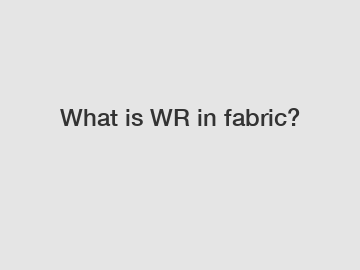What is WR in fabric?
When it comes to selecting fabrics for various applications, you might have come across the term "WR." Wondering what WR stands for and why it is crucial? In this blog, we'll delve into the world of fabric composition, waterproofing, and how WR plays its part in enhancing fabric functionality. So, grab a cup of coffee and let's dive in!
Understanding WR - Waterproofness and Water Resistance:
WR, an abbreviation for Water Repellency, denotes the ability of a fabric to resist the penetration of water. While being water repellent implies that a fabric resists water effectively but isn't completely waterproof, it provides an additional level of protection against moisture and ensures comfort in damp conditions.

Types of WR:
There are primarily two types of WR finishes commonly used in fabrics:
1. Durable Water Repellent (DWR): DWR is a long-lasting treatment applied to the fabric's outer surface. It forms a protective layer that makes water bead up and roll off the fabric rather than being absorbed. DWR-treated fabrics are commonly used in outdoor apparel, tents, and activewear, allowing users to stay dry and comfortable even in wet conditions.
2. Non-Durable Water Repellent (NDWR): Unlike DWR, NDWR finishes are temporary and lose their effectiveness over time due to usage, washing, or exposure to the elements. Fabrics with NDWR require periodic reapplications of repellent sprays or wash-in treatments to maintain their water repellency.
Factors Determining WR Performance:
Several factors influence the water repellency of a fabric. Here are a few key factors to consider:
1. Fabric Composition: The choice of fibers used in fabric affects its WR performance. Synthetic fibers like nylon and polyester tend to naturally repel water, whereas natural fibers like cotton and silk lack intrinsic water resistance and require additional treatments to become water repellent.
2. Fabric Construction and Finish: Different fabric weaves and treatments affect WR. Textile manufacturers often use special coatings, laminations, or chemical finishes to enhance the fabric's water repellency. These treatments prevent water from saturating the fabric.
3. Care and Maintenance: Regular cleaning methods, such as machine or hand washing, can gradually diminish the effectiveness of the WR finish. Therefore, it is important to follow the manufacturer's instructions for proper care to extend the fabric's water repellency.
Importance of WR in Different Applications:
The significance of WR in various industries cannot be understated. Let's explore a few:
1. Outdoor Apparel: Whether you enjoy hiking, mountaineering, or camping, having water-repellent garments ensures that you can stay comfortable in unpredictable weather conditions. WR outerwear protects you from rain, snow, and sleet while allowing moisture vapor to escape, preventing you from feeling clammy and cold.
2. Sports and Activewear: From running to cycling, WR fabrics in sports and activewear keep you dry and focused during intense physical activities. These fabrics wick away sweat while providing a barrier against external moisture, maintaining body temperature and maximizing performance.
3. Upholstery and Home Furnishings: Water repellent fabrics find their place in upholstery, curtains, and outdoor furniture covers. WR treatments help prevent stains and damage caused by accidental spills or exposure to moisture, extending the lifespan and durability of household fabrics.
Wrapping Up:
By now, you understand the importance of WR in fabric and how it contributes to the overall performance and comfort of various products. Whether you're planning an outdoor adventure or looking for everyday garments, considering fabrics with excellent water repellency can significantly enhance your experience.
Remember to check the specific care instructions for maintaining WR functionality in your garments, as improper care may render the water repellent treatment less effective over time. By investing in high-quality, WR-treated fabrics, you ensure long-lasting performance, keeping yourself dry and comfortable in any situation.
So, when you're out there shopping for your next gear or wardrobe upgrade, keep an eye out for fabrics boasting excellent water repellency qualities. Stay dry, stay comfortable, and embrace the great outdoors, come rain or shine!
Want more information on 55 cotton 45 polyester fabric, 100% cotton poplin fabric price, chief value of cotton? Feel free to contact us.
295
0
0


Comments
All Comments (0)